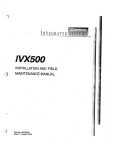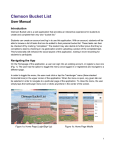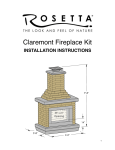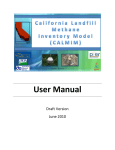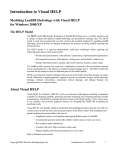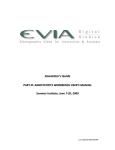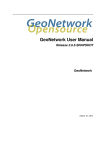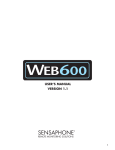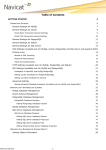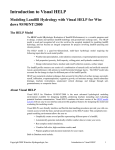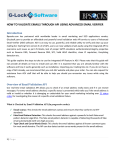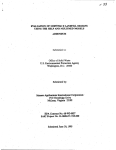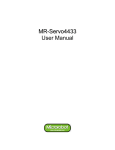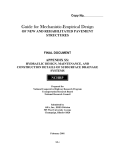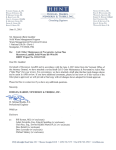Download Users Manual - The Ohio Air Quality Development Authority
Transcript
LANDFILL COST MODEL FOR DISPOSAL OF COAL COMBUSTION PRODUCTS USER’S MANUAL Funded in part by the Ohio Coal Development Office Department of Development, State of Ohio and CONSOL Energy Inc. GAI Consultants, Inc. Trumbull Corporation Issue Date: November 2002 Created by: D. A. Kosmack Version 1.0 © Copyright CONSOL Energy Inc., 2002 Landfill Cost Model for Disposal of Coal Combustion Products User’s Manual DISCLAIMER CONSOL Energy Inc. does not warrant that the program provided is free from coding errors or other defects. Use of the program is at the user’s sole risk. The program software and associated documentation may contain defects, fail to comply with application specifications, and may produce unintended or erroneous results when operated by itself or in combination with other hardware or software products. The program is provided “as is”. The user accepts the program provided by CONSOL Energy Inc. “as is” and assumes all risks associated with its use, quality, and performance. To the extent permitted by law, CONSOL Energy Inc. expressly disclaims any and all warranties, whether express or implied, including the implied warranties of merchantability and fitness for a particular purpose and all warranties as to the accuracy, completeness, and non-infringement of the program, used either alone or with third party software. -2- Landfill Cost Model for Disposal of Coal Combustion Products User’s Manual TABLE OF CONTENTS 1. 2. 3. 4. 5. 6. 7. Introduction......................................................................................................................5 Background.....................................................................................................................6 Model Logic ....................................................................................................................7 Basic Operating Steps ..................................................................................................9 Detailed Descriptions and Assumptions 5.1 Code Regulations ............................................................................................14 5.2 Waste Production Calculation ........................................................................15 5.3 FGD Waste Mass Balances ...........................................................................18 5.4 Waste Bulk Densities ......................................................................................20 5.5 Calculation of Waste Volume..........................................................................21 5.6 Landfill Sizing and Design...............................................................................22 5.7 Indirect Capital Cost Algorithms.....................................................................27 5.8 Direct Capital Cost Algorithms.......................................................................27 5.9 Total Capital Requirements ............................................................................31 5.10 Operating and Maintenance Costs ................................................................31 5.11 Post-Closure Costs..........................................................................................34 5.12 Total Landfill Costs and Economics...............................................................36 5.13 Uncertainty of the Estimates ...........................................................................39 System Requirements .................................................................................................40 Troubleshooting ............................................................................................................40 APPENDICES Appendix A - Summary of Critical Inputs ...........................................................................49 Appendix B - Example Run for Ohio Class III with Geomembrane .................................58 -3- Landfill Cost Model for Disposal of Coal Combustion Products User’s Manual LIST OF TABLES Table I - Components of Waste Stream Generated by Different FGD Systems...........19 Table II - Bulk Density as a Function of % Dry Solids for Wet FGD Sludge ..................20 Table III - Landfill Model Troubleshooting Recommendations .........................................48 Table A1 - Summary of Critical Input Data ........................................................................49 LIST OF FIGURES Figure 1 - Flow Chart for OCDO Landfill Cost Model ........................................................8 Figure 2 - Critical Data Input Sheets..................................................................................10 Figure 3 - Layers of a Landfill Construction as Dictated by Code Regulation Presented from Top to Bottom ..........................................................................30 Figure A1 - Output of CCP (includes Plant and Scrubber Input) Data Sheet................52 Figure A2 - Landfill Design Input Data Sheet....................................................................53 Figure A3 - Landfill Geometry Input Data Sheet - Flat Terrain........................................53 Figure A4 - Landfill Geometry Input Data Sheet - Valley Fill ...........................................54 Figure A5 - Landfill Geometry Input Data Sheet - Side Hill Fill .......................................54 Figure A6 - Capital Costs Input Data Sheet......................................................................55 Figure A7 - Operating and Maintenance Input Data Sheet .............................................55 Figure A8 - Post-Closure Input Data Sheet.......................................................................56 Figure A9 - Economic Input Data Sheet............................................................................56 Figure A10 - Additional User-Defined Capital Cost Items ..............................................57 -4- Landfill Cost Model for Disposal of Coal Combustion Products User’s Manual 1. INTRODUCTION This document provides an overview of the Landfill Cost Model for Coal Combustion Products developed by CONSOL Energy Inc. in conjunction with GAI Consultants and Trumbull Corporation. This project was funded in part by the Ohio Coal Development Office, Department of Development, State of Ohio. The objective of the project was to produce and disseminate a flexible, userfriendly computer model that predicts the capital and operating costs of new landfills for disposal of a variety of coal combustion products (CCPs), including flue gas desulfurization (FGD) scrubber byproducts. The model will provide a representative cost for a landfill to be used as a benchmark for comparing alternative processes that utilize coal combustion byproducts. The model has the flexibility of using default values for various design and cost input parameters if the user is unfamiliar with the details of landfill construction. Code regulations from Ohio, Pennsylvania, and Kentucky have been included in the model development. The specific state selected will primarily affect the construction of the landfill liner. Three different land topographies available for landfilling can be selected by the user. The quantity of material to be landfilled can be input by the user or allow the program to calculate the amount of waste material based on power plant parameters. These include size of the power plant, type of coal that is being burnt, and the type of scrubbing system that is at the plant. The model calculates the construction costs to build the landfill, the operating costs to maintain it through the life of the landfill, and post-closure expenses required to maintain it after it is filled. Operating costs include the cost to load, transport, fill, and grade the coal combustion waste as well as monitoring and general maintenance of the site. Post-closure activities include a continued monitoring program and site maintenance. The model provides a total cost on a cost/ton basis for all activities that are associated with landfilling CCPs, including a specified internal rate of return. -5- Landfill Cost Model for Disposal of Coal Combustion Products User’s Manual 2. BACKGROUND The state of Ohio generates approximately 10 million tons per year of Coal Combustion Products (CCPs). This is being produced by coal-fired electric generating power plants with or without FGD scrubbers. The scrubber capacity is projected to increase to meet the 1990 Clean Air Act Amendments Phase II sulfur dioxide emission requirements. The quantities of fly ash and bottom ash will increase with the projected increase in electrical demand in the United States. Disposal or use of CCPs will become an increasingly important environmental and economic issue. Power plants must balance the demand of meeting environmental requirements while producing the lowest cost electric power in a deregulated, competitive electric power market. Waste disposal, in either on-site or off-site landfills, can be a significant cost. These landfill sites have a fixed capacity that is rapidly becoming exhausted. New landfills constructed today have more stringent environmental requirements, higher level of public awareness, and fewer available potential sites. These factors will all increase the cost of developing a new landfill today. Accurate cost information is needed by utilities to make the most economical and environmentally sound decision on CCP disposition when existing landfill capacities are exhausted. Information is also needed by the alternative use developers to serve as a benchmark to compare new processes. A cost model will allow a power plant or alternative use developer to evaluate the economic trade-off between landfill disposal and beneficial uses of the CCPs. Fly ash, and FGD sludge have uses in concrete manufacture, as a roadbed material, and in production of manufactured aggregate. The cost estimates may also affect the decision on type of scrubber a power generator may install to reduce sulfur dioxide emissions. For example, a limestone forced oxidation scrubbing system may show overall better economics since it produces salable gypsum used in wallboard versus having to landfill the byproducts. -6- Landfill Cost Model for Disposal of Coal Combustion Products User’s Manual 3. MODEL LOGIC The Landfill Cost Model for Coal Combustion Products consists of 26 spreadsheets that were created in a Microsoft Excel 2000 Workbook format, with interfaces and supporting code developed in Visual Basic. The spreadsheets in the model are organized into four main sections: capital costs, scrubber analysis, operating and maintenance activities, and post-closure activities. Within each of these categories are data input sheets and results sheets. Code regulation sheets, landfill geometry calculation sheets, a project summary sheet, and an economics sheet are components of the complete model. The flow chart, Figure 1, illustrates the main critical inputs needed for the calculations and the results that are generated. The worksheets are labeled as follows: 1. Menu 2. Quick Start 3. Main Input 4. Capital Results 5. Scrubber Input 6. Scrubber Results 7. Scrubber Material Balance 8. Scrubber Data 9. Operating & Maintenance Inputs 10. Operating & Maintenance Results 11. Post-Closure Inputs 12. Post-Closure Results 13. Summary -7- 14. Economics 15. Depreciation 16. User Defined Codes 17. State Codes 18. Flat Geometry 19. Flat Calculations 20. Flat Program 21. Valley Geometry 22. Valley Calculations 23. Valley Program 24. Side Hill Geometry 25. Side Hill Calculations 26. Side Hill Program Landfill Cost Model for Disposal of Coal Combustion Products User’s Manual Figure 1 Flow Chart for OCDO Landfill Cost Model Pick State: Ohio PA Kentucky Pick Code:Ohio Class II Ohio Class III- no geomembrane Ohio Class III- geomembrane PA Class I PA Class II Kentucky User Defined Select geomembrane, cap material, and drainage system Input volume of CCP produced? NO Input: Coal Parameters Power Plant size Input Scrubber Type & Parameters: Forced Oxidation Natural Oxidation Thiosorbic Lime Lime Spray Dryer None Calculate the density and cubic yards of CCP YES Results: Scrubber Balance Pick Geometry & Dimensions: Flat Valley Sloped Hill Input Landfill Life Input Operating Parameters Input Economic Parameters Input post-closure period Calculate acreage of landfill Calculate landfill operating, maintenance, & transportation costs Results: Operation Costs Calculate landfill capital cost using codes & cost components. Results: Capital Costs Calculate Economics Results: Final Landfill Cost -8- Calculate landfill post-closure costs Results: PostClosure Costs Landfill Cost Model for Disposal of Coal Combustion Products User’s Manual 4. BASIC OPERATING STEPS Upon opening the model, the user will be directed to the Menu worksheet. This worksheet has a series of buttons that step the user through the model and provide limited error messages when appropriate. There are five steps that can be followed to calculate landfill costs based on the criteria input by the user. In general terms, step 1 is entering critical input data, step 2 is entering optional input data, step 3 is performing design and cost calculations, step 4 is viewing the results, and step 5 is printing the results. Step 1. Click on the button labeled “Start Interface for Critical Data Inputs”. This will open a series of input sheets that allow the user to input key information as shown in Figure 2. The sheets are indexed to group inputs based on area of interest. The tabs at the top of each sheet allow the user to switch from sheet to sheet. The sheets are grouped as: Code Input Output of CCP (includes Plant and Scrubber Inputs) Landfill Design Capital Costs Operating & Maintenance Inputs Post-Closure Inputs Economics The description of each is defined in Section 5 – Detailed Descriptions and Assumptions. The values appearing in the white boxes are the inputs that the model will use for calculations. Any of the items can be changed with the help of the pull down window or typed directly into the box. An expected range and default value is provided to assist in defining the variables. Typing a “D” will insert the default value into the model. On the Code Input, as shown in Figure 2, the user must input the state (Ohio, Pennsylvania, or Kentucky) where the landfill is being constructed and what regulatory code applies. If User Defined code is selected, the program will send the user to the User Defined Codes worksheet when the user exits the input form. A selection of geomembrane type is always required for the primary liner -9- Landfill Cost Model for Disposal of Coal Combustion Products User’s Manual and sometimes for the secondary liner and cap. If the user defines his/her own geomembrane type, additional boxes will prompt the user to provide the description and cost on a dollars/square yard basis. The drainage type must always be selected for the leachate but not always for the leak detection zone. Illustrations of the other critical input sheets are provided in Appendix A – Figures A1 thru A10. The model has the capability of calculating the quantity of coal combustion products generated from a power plant based on operating parameters or allowing the user to input a known yearly quantity. If the quantity is unknown, plant and scrubber data will be used to calculate the CCP quantity produced and landfilled. Additional input boxes will become visible so that the user can provide power plant operating parameters, coal properties, scrubber type, and percent of waste to be landfilled. See Section 5.2 – Waste Production Calculation for definition of the input terms. Figure 2 – Critical Data Input Sheets - 10 - Landfill Cost Model for Disposal of Coal Combustion Products User’s Manual The Landfill Design input sheet requires the user to provide information on the amount of site excavation that is required at the landfill site. The excavated material may be used for cover soil and liners if soil characteristics are appropriate. The user also must select the configuration of the landfill. Clicking on the Landfill Dimension button allows the user to input the specific dimensions required to perform the calculations on the geometry selected. A Show Landfill Geometry button on the dimension form will allow the user to view the geometry. See Section 5.6 – Landfill Sizing and Design for detailed explanation of the design calculations and Section 5.8 – Direct Capital Cost Algorithms for information about excavating. The Capital Costs input sheet allows the user to input the landfill life. It also provides the opportunity for the user to divide the construction period into stages or cells. The number of years for each stage of construction is input by the user with the program assuring that the total years of construction equals the landfill life. The final number of stages used will be calculated. Any user-defined capital cost item can be input using the Add User-Defined Capital Cost Items button. A description and lump sum cost is required. There is allocation for five items to be input in the pop-up window. There is additional space for five more items on the main input sheet if the user has extra miscellaneous items. The remaining input sheets can be clicked on, and the requested information filled in by the user. For more details on the required parameters see Section 5.10 – Operating and Maintenance Costs, Section 5.11 – Post-Closure Costs, and Section 5.12 – Total Landfill Costs and Economics. The Exit Input Form must be clicked on for the user to exit the pop-up window and return to the Menu worksheet. A summary of all critical input data is listed in Table AI – Appendix A. - 11 - Landfill Cost Model for Disposal of Coal Combustion Products User’s Manual Step 2. Click inside the box labeled “Links to Additional Input Locations” to the specific area that describes the additional input information the user is interested in changing. The areas are similar to the descriptions of the input form and are defined as: Regulations Waste Production Inputs Landfill Design Inputs Capital Cost Inputs Scrubber Inputs Operating and Maintenance Inputs Post-Closure Inputs Economic Inputs The user will be transferred to the specific worksheet where the information can be input. Any text that is pink is a critical input that was part of the input forms. All items in blue are input values that can be changed. Any green item is a critical number calculated from the program that cannot be altered. As a start, it is recommended to only change the critical inputs from the pop-up windows. As the user becomes more familiar with the model, the worksheets provide the flexibility to change all input parameters. Range and default values are provided to assist the user in defining reasonable values. Comment boxes and red messages are scattered through the worksheets to provide helpful hints to input data and troubleshooting. The user can manually tab, use the arrow keys, or click on the Go To Menu button within the worksheet to get back to the Menu worksheet and link to another sheet. The model has been set up so that the user is unable to edit, add, or delete any formula contained in the worksheets of the model. The blue input cells are unlocked and can be changed while the remainder of the cells on all sheets is read-only. Step 3. Click the Run button when all the input values are acceptable to the user. The program will calculate the acreage of the landfill and calculate total project costs. If any input value is changed, the run button must be clicked again to provide final results. Warning messages appear in the yellow window on the Menu page to indicate if there are any problems. Warning messages appear throughout the program to help troubleshoot a problem. There are four - 12 - Landfill Cost Model for Disposal of Coal Combustion Products User’s Manual additional calculation buttons in the model to aid in troubleshooting. Each additional button is specific for one calculation, where as the Run button on the main Menu will perform all the appropriate calculations at one time. There is a calculation button on the Economics worksheet to perform the internal rate of return (IRR) calculation. There are also calculation buttons on the Flat Program, Valley Program, and Sidehill Program to calculate the results for the specific geometry. Step 4. Click inside the box labeled “Links to View Results” to view the topic that is of interest. The topics include: Summary Economics Details Capital Results Details Operating & Maintenance Results Details Post-Closure Results Details Scrubber Results The summary page combines all the costs with key components identified. Comments are provided on the regulatory requirements for the specific code selected. The economics page combines all landfilling charges required to meet the required Internal Rate of Return specified. The other result sheets provide detailed information on the specific result. The line items on the results worksheets are very similar to the input sheets but with calculated results. The user can manually tab, use the arrow keys, or click on the Go To Menu button to get back to the Menu worksheet and link to another sheet. Step 5. Check the box or boxes on the “Select Reports to Print” section to choose any results of interest. Any result that can be viewed can be printed. Click the Print Selected Reports button to print the document. The Excel Print option can also be used to print any worksheet of interest. Each worksheet has a defined print area, which may not include the entire worksheet. - 13 - Landfill Cost Model for Disposal of Coal Combustion Products User’s Manual 5. DETAILED DESCRIP TIONS AND ASSUMPTIONS 5.1. C ODE REGULATIONS The model contains the code regulations for the states of Ohio, Pennsylvania, and Kentucky. For Ohio, they are grouped under Ohio Class II, Ohio Class III with no geomembrane, and Ohio Class III with geomembrane. Pennsylvania, it includes PA Class I and PA Class II. For Kentucky code is not broken into any specific class. A waste site that is accepting coal combustion products would be classified under one of these codes in the specified state. An option is available for the user to define his/her own code. It is suggested the user select a code that is closest to the constraints that are imposed and only modify the specific items that are different. For example, the user may select Ohio Class III with geomembrane and increase the thickness of the clay component of the primary liner from 18 inches to 24 inches. This line item would be the only component the user would change on the User Defined Codes and he would run the model with all the other constraints from the code. The model has the flexibility for the user to deviate in all areas related to the liner installation. The options selected for liner adjustments must be in agreement between the critical input information and the User Defined Code information to make a change to the codes. It is best to select the type of geomembranes for the primary liner, secondary liner, and cap on the critical data Code Input pop-up window. The user also needs to select the drainage type for the leak detection zone and leachate on the Code Input form or the main input worksheet before making changes to the User Defined Code worksheet. On the User Defined Code worksheet the user must input a “1” which means YES into the cell corresponding to the selected geomembrane or drainage type. The codes are used to control the installation of the layers and liners in the program. They are also linked to the number of years post-closure activities are required. The regulations effective January 2001 were incorporated into the model. The specific code regulations for each state were Chapter 3745-30 of the Administrative Code of Ohio, the Pennsylvania Code - Title 25. Environmental - 14 - Landfill Cost Model for Disposal of Coal Combustion Products User’s Manual Protection - Chapters 287-299, and 401 Kentucky Administrative Regulations (KAR) - Chapters 30, 40, 45, 47, 48, and 49. 5.2. WASTE PRODUCTION CALCULATION Waste production can be input in two ways. If the user knows the quantity of coal combustion products that is generated at the power plant that will need to be landfilled, he/she can input the tonnage on a yearly basis. The user is also asked to input the bulk density on a lb/ft3 basis. The program converts this to volume of material in cubic yards to calculate the landfill geometry. If the user does not know the quantity, he/she can answer NO to the question “Is the yearly output of CCP known?”, and the program will calculate the generation of coal combustion waste based on input parameters around the power plant. The list of power plant variables that are used to calculate the waste products can be grouped into coal properties on an as-received basis, power plant operation, and scrubber information. Since some of the byproducts can be used for other purposes, the percentage of each byproduct to be landfilled is requested. A list and brief description of critical inputs associated with the boilers and electrostatic precipitators (ESPs) follows. Coal heating value or energy value – The design coal higher heating value as-received in Btu/lb. Coal sulfur – The design coal sulfur content as-received in weight percent. Coal ash – The design coal ash content as-received in weight percent. Station or plant rating – The gross megawatt rating of the power plant or unit. Station or plant net capacity factor – The net capacity factor of the power plant or unit in percent. - 15 - Landfill Cost Model for Disposal of Coal Combustion Products User’s Manual Station or plant heat rate – The station net plant heat rate in Btu/kWh. More detailed inputs in regard to the boilers and ESPs, intended for the experienced model user, can also be varied. These include: Boiler ash split – The split between bottom ash and fly ash in lb fly ash/ lb total ash. ESP efficiency – The collection efficiency of the electrostatic precipitators as a percent. The model can evaluate several options for FGD scrubber systems. They include limestone forced oxidation, limestone natural oxidation, thiosorbic lime, spray dryer, and no scrubber. The limestone forced oxidation, limestone natural oxidation, and thiosorbic lime are all classified as wet once-through flue gas desulfurization processes while the lime spray dryer is a dry once-through process. In the wet technologies, SO2-containing flue gas contacts alkaline aqueous slurry in an absorber. The slurry is generally made from either lime or limestone. In the absorber and holding tank, SO2 dissolves in the slurry and reacts with dissolved alkaline particles to form sulfite/sulfate crystals. Limestone forced oxidation (LSFO) produces a salable gypsum (calcium sulfate dihydrate) byproduct if the flue gas has first been passed through an electrostatic precipitator to remove a high percentage of the fly ash produced from the boiler. In the once-through dry FGD technology the SO2-containing flue gas contacts alkaline sorbent. In a lime spray dryer (LSD), a lime slurry is dispersed into the flue gas. The flue gas mixes in a spray dryer vessel with a mist of finely atomized fresh lime slurry. Simultaneous heat and mass transfer between alkali in the finely dispersed lime slurry and SO2 from the gas phase results in a series of reactions and a drying of reacted products. particulate control device. - 16 - This occurs upstream of the Landfill Cost Model for Disposal of Coal Combustion Products User’s Manual The additional inputs pertaining to the FGD system for the plant are also intended for the experienced model user. SO2 removal – The target sulfur dioxide removal level in percent. The default value for limestone forced oxidation, limestone natural oxidation, and thiosorbic lime is 95%. The default value for lime spray dryer is 85%. FGD particulate collection efficiency – The percentage of ash removed in the scrubber based on the particulate collection efficiency of the scrubber. The default value is 50% based on an inlet loading. Reagent purity – The weight percent purity of the scrubber reagent, either lime or limestone. The impurities are treated as inerts. Filter cake % solids – The weight percent solids on the filter cake that is produced from the wet scrubber systems. The default value for forced oxidation is 90%, which also represents the final percent solids that is landfilled. For natural oxidation the default value is 60% and for thiosorbic lime the value is 45%, which represent the solids in the dewatered sludge to which fly ash will be added. Spray dryer % solids - The weight percent solids of the material discharged from the spray dryer. The default value is 95%, which refers to the percent moisture subtracted from 100. % Dry solids in landfilled material - The weight percent of dry solids generated from a lime spray dryer in the final material that will be landfilled. Moisture has to be added to the solids discharged from the spray dryer for disposal in a landfill. The default value is 65%. Ratio SO3/SO4 - The mole percent of sulfite expressed as a ratio of sulfite/sulfate waste. This is used to calculate the quantity of calcium - 17 - Landfill Cost Model for Disposal of Coal Combustion Products User’s Manual sulfite and calcium sulfate in the waste. The default is 0% for limestone forced oxidation, 80% for limestone natural oxidation and thiosorbic lime, and 90% for lime spray dryer. Reagent stoichiometry Ca/S – The required ratio of moles of active reagent to moles of removed SO2. Default values are 1.10 for limestone forced oxidation, 1.30 for limestone natural oxidation, and 1.10 for thiosorbic lime. For the lime spray dryer case the convention for reagent stoichiometry is based on moles of active reagent to moles of SO2 input. The SO2 removed is internally calculated in the program. The default value is 1.60. Fraction unreacted reagent going to CaCO3 - The mole fraction of lime forming calcium carbonate. This only applies to lime spray dryers. The default value is 0.30. Fly ash fixation ratio – The fly ash fixation ratio is the pounds of fly ash per pound of dry filter cake needed to stabilize the material. Default values are 0.6 lb/lb for limestone natural oxidation and 1.25 lb/lb for thiosorbic lime. It is assumed that neither limestone forced oxidation nor lime spray dryer require fly ash fixation. Lime fixation ratio – The lime fixation ratio is the pounds of lime per pound of dry FGD solids needed to stabilize the material. Default values are 0.02 lb/lb for limestone natural oxidation and 0.03 lb/lb for thiosorbic lime. It is assumed that neither limestone forced oxidation nor lime spray dryer require lime fixation. 5.3. FGD Waste Mass Balances Once the required input variables are entered, an itemized mass balance of waste stream components is calculated. Components of the waste streams generated by each type of FGD systems are provided in Table I below. - 18 - Landfill Cost Model for Disposal of Coal Combustion Products User’s Manual Table I – Components of Waste Stream Generated by Different FGD Systems Type of Scrubber No Limestone Limestone Thiosorbic Lime scrubber forced natural Lime Spray oxidation oxidation Dryer LSFO LSD Components of FGD Waste Stream Gypsum CaSO4•2H2O CaSO4• 12 H2O CaSO3• 12 H2O Unreacted limestone – CaCO3 Unreacted – lime –Ca(OH)2 Produced CaCO3 Water Reagent inerts & FGD-collected fly ash Fixation fly ash Fixation lime Ca(OH)2 Fly Ash Yes Yes Yes Yes Yes Yes Yes Yes Yes Yes Yes Yes Yes Yes Yes Yes Yes Yes Yes Yes Yes Yes Yes Yes Yes Components of Boiler Waste Stream Fly Ash Yes Yes Bottom Ash Yes Yes - 19 - Yes – used to fixate may not have excess waste Yes Yes – used to fixate may not have excess waste Yes Yes – all part of FGD waste Yes Landfill Cost Model for Disposal of Coal Combustion Products User’s Manual Since limestone forced oxidation produces a high weight percent solids product and does not require fixation, the total quantity of waste production will be significantly less relative to the natural oxidation and thiosorbic lime processes (all other factors being equal). 5.4. WASTE BULK DENSITIES Bulk densities for the waste of each FGD process were derived from published data. The following is a description of the bulk density data used in calculating disposal volumes for each FGD process. Limestone force oxidation – The compacted bulk density of gypsum (1020 weight percent water) was reported to be 95 lb/ft3. (Reference Shawnee Flue Gas Desulfurization Computer Model users Manual, EPA/TVA-600/8-85/006, 1985) Limestone natural oxidation – Bulk density as a function of weight percent solids for wet sludge (non-fixated) was reported in an EPRI study (Utilization Potential of Coal Combustion Byproducts – Somerset Power Plant Case Study, Michael Baker, 1987). Values of bulk densities for the range of likely percent dry solids are shown in Table II below. Table II – Bulk Density as a Function of % Dry Solids for Wet FGD Sludge % Dry Solids 40 45 50 55 60 65 70 Compacted Bulk Density of Wet Sludge, lb/ft3 81.58 84.85 88.18 92.25 96.45 100.85 105.82 - 20 - Landfill Cost Model for Disposal of Coal Combustion Products User’s Manual Once the wet sludge bulk density is determined, adjustments must be made to account for the fixation fly ash and lime. A bulk density of 80 lb/ft3 was assumed for both the fly ash and lime. Using the mass balance, the overall compacted bulk density was obtained by weight averaging the wet sludge, fly ash, and lime compacted bulk densities. Thiosorbic lime – The EPRI wet sludge bulk densities used for the limestone natural oxidation system were also used for the thiosorbic lime system (adjusting for percent dry solids). This value was then adjusted for fixation fly ash and lime to calculate the final compacted bulk density. The waste products generated from the boiler are the bottoms ash and fly ash. In the wet systems, the fly ash is passed through an electrostatic precipitator that can remove over 95% of the ash. This ash can then be used to fixate the FGD sludge to produce an adequate consistency for landfilling. If it is a low ash high sulfur coal, it may be necessary to purchase fly ash for this process. On the contrary, if it is a high ash low sulfur coal there may be excess fly ash and it is optional if this material is to be landfilled or sold. The bottom ash produced from the boiler can either be sold or landfilled. This option is also available for the producer of the gypsum. It may be possible to sell the byproduct instead of sending it to a landfill. The model provides the flexibility of inputting the percentage of these components that is to be landfilled. This then becomes added to the waste production on an annual basis. 5.5. C ALCULATION OF WASTE VOLUME The bulk density is used to convert the annual waste in tons to annual waste volume in cubic yards. By multiplying the annual tons by 2000 and dividing by the compacted bulk density the annual cubic yards can be determined. The total capacity of the landfill, in compacted cubic yards is obtained by multiplying the annual cubic yards by the design life in years of the landfill. - 21 - Landfill Cost Model for Disposal of Coal Combustion Products User’s Manual 5.6. L ANDFILL SIZING AND DESIGN The design of the landfill follows guidelines used by the Electric Power Research Institute – EPRI (FGD Byproduct Disposal Manual, Third Edition, CS-2801 and Fourth Edition EPRI- TR-104731s). Three basic geometries were selected for landfill designs. Variations can be made with each type. They include flat terrain, valley fill, and side hill fill. A landfill built on a flat terrain is designed as a truncated pyramid with the shortest side defined as the width of the structure. The pyramid has a flat top. The height and width are input by the user. The program will calculate the volume of a frustum of the pyramid and compare it to the desired volume of waste to be landfilled. The equations to calculate the volume of a frustum are in terms of the length of bottom sides at grade, the length of the top sides, and height. The slope of the sides is fixed at 3 to 1 or 18 degrees, which then constrains the length of the top. The initial calculation assumes that the pyramid is equilateral with the length equal to the input width. If the calculated volume of the landfill is not within 5% of the CCP volume, then an adjustment is made to the length of the base. It assumes an incremental length of 300 feet and then calculates a new volume based on the new dimensions of a frustrum of a pyramid. The new volume is compared again to the desired fill. Extension of the base continues to be added until the volume is within 5% or less of the desired volume. The incremental length may need to be changed in order for the program to converge. The program provides the user the flexibility to change the value of the incremental length on the Valley Calculation worksheet. A variation on this geometry is to allow the user to build below the surface and dig out the area underneath the truncated pyramid so it appears as an inverted truncated pyramid. The assumptions used for the below ground volume calculation were that the perimeter of the pit was the same as the perimeter of the above ground truncated pyramid and only the depth could vary. The sides of the pit must also maintain a 3 to 1 slope as it descends below the surface. The - 22 - Landfill Cost Model for Disposal of Coal Combustion Products User’s Manual material that is excavated defines the depth below ground used. See more details about excavation under Section 5.8 - Direct Capital Cost Algorithms. The critical input variables provided by the user are h – The height or distance from the flat terrain to the highest point above grade in feet. W2 – Bottom width of landfill at grade in feet (smaller of length and width dimension which will fit on the available site). hb – The depth below the surface in feet (sum of depth of cover soil, depth of clay, depth of subgrade). The equations used can be viewed on the Flat Geometry and Flat Calculations worksheets in the model. The incremental length expansion calculations can be viewed on the Flat Program worksheet in the model. A calculation button on the Program worksheet allows the user to run just the flat fill program to calculate the area. This should be used for troubleshooting the dimensions of the flat fill. The Run button on the main Menu must be run to obtain a complete set of economic results. If a solution to the volume calculation is not possible with the input parameters provided, the user will be prompted to the Landfill Dimension input form to modify the geometric parameters and run again. In a valley fill, an existing natural valley is used as a landfill. The configuration from a plan view would be a trapezoid where the front width is longer that the back width, with the front and back being parallel sides. The slope of the side and back walls of the valley can all be varied from 5 to 18 degrees. The slope of the front walls built from the CCPs is fixed at 3 to 1 or 18 degrees. The model allows the plan view configuration to transform into a triangle in which the back width diminishes to a point. The input to the program is the top front width, top back width, the length of the top, angle of slope of the hill on the left side, angle of slope of the hill on the right side, angle of slope of the hill on the back side. - 23 - Landfill Cost Model for Disposal of Coal Combustion Products User’s Manual The program incrementally builds the landfill from top to bottom. It assumes an incremental height of 10 feet and then calculates the volume of that section by calculating the average area of the trapezoid and multiplying it by the incremental height. It compares the volume calculated with the desired volume needed to landfill. If the numbers are not within 5%, then it adds another layer. The front and back widths of the incremental layers are adjusted for the angle of the sloped sides. Therefore, the incremental plan area gets smaller with depth. A new volume is calculated and added to the first increment. Volumes are compared again to the desired fill. Layers continue to be added until the volume is within 5% or less of the desired volume. The incremental heights are then added to provide a total height of the waste fill. There are rare occasions when the incremental height will need to be changed in order for the program to converge. The incremental height can be decreased to tighten the convergence on the volume calculation. The program provides the user the flexibility to change the value of the incremental height on the Valley Calculation worksheet. An optional input parameter defining the width of the bottom of the landfill can be provided by the user. The program will compare this number with the calculated value and provide a message to the user if the values are within 5%. This feature would be used if the user has a specific area with exact dimensions that is trying to be used for a landfill. If the actual width of the floor of the valley is less than the calculated value, then the model, as set up, does not adequately match the specific case. To have the model more accurately match the land dimensions and follow standard construction practices, the starting width of the fill should be decreased and the results recalculated. If the actual width of the valley floor is greater than the calculated value, then the initial top width should be increased and the program run again. The critical input variables provided by the user are: W2 – Width of the top front in feet. W3 – Width of the top back in feet. L – Length of the top or distance between W2 and W3. - 24 - Landfill Cost Model for Disposal of Coal Combustion Products User’s Manual a – Angle of slope of the hill on left side in degrees. b – Angle of slope of the hill on right side in degrees. d – Angle of slope of the hill on back side in degrees. W6 (Optional) – Width of the bottom front in feet. The equations can be viewed on the Valley Geometry and Valley Calculations worksheets in the model. The incremental layer calculations can be viewed on the Valley Program worksheet in the model. A calculation button on the Program worksheet allows the user to run just the valley fill program to calculate the area. This should be used for troubleshooting the dimensions of the valley. The Run button on the main Menu must be run to obtain a complete set of economic results. If a solution to the volume calculation is not possible with the input parameters provided, the user will be prompted to the Landfill Dimension input form to modify the geometric parameters and run again. The side hill fill uses the side of a hill as the base of the landfill and then builds it up. The assumption is that the existing hillside must have a slope less than 18 degree. It fills the side hill up to 18 degrees and can extend onto the flat plane. This continues to build the thickness of the 18-degree front layer. It is an iterative process to obtain the final dimensions of the landfill. The program builds the fill from the bottom up. It starts with the width of the bottom and the existing angle of the hillside and builds a layer of an incremental height of 10 feet that will fill in the volume to get an 18-degree angle on the front. It uses the volume of triangular and rectangular prisms calculated with the given length. The calculated volume of the landfill has to be within 5% of the desired volume of waste. If it is not, then a second layer is added to build a volume that extends the existing hill surface to 18 degree. It continues to build the landfill until the volumes are within 5% or better. If there is flat land that is being filled as well, it adds that portion to the volume on an incremental basis also. When the volumes match, the incremental heights are added to obtain the full height of the landfill. The final width may be less than the original value if the desired volume was reached before the landfill was filled to the maximum available height. There are - 25 - Landfill Cost Model for Disposal of Coal Combustion Products User’s Manual rare occasions when the incremental height will need to be changed in order for the program to converge. The incremental height can be decreased to tighten the convergence on the volume calculation. The program provides the user the flexibility to change the value of the incremental height on the Side Hill Calculation worksheet. The critical input variables provided by the user are: W2 – Width of the bottom of the landfill in feet. x – Existing terrain slope in degrees. L – Length of the bottom of the landfill in feet. W9 – Width of the flat plane in feet. The equations can be viewed on the Side Hill Geometry and Side Hill Calculations worksheets in the model. The incremental layer calculations can be viewed on the Side Hill Program worksheet in the model. A calculation button on the Program worksheet allows the user to run just the Side Hill Program to calculate the area. This should be used for troubleshooting the dimensions of the side hill. The Run button on the main Menu must be run to obtain a complete set of economic results. If a solution to the volume calculation is not possible with the input parameters provided, the user will be prompted to the Landfill Dimension input form to modify the geometric parameters and run again. A 20% design factor is used on all configurations to account for buffer acres needed for the landfill. The final width is increased by 20% to account for this acreage. The program does provide the flexibility to change the factor on the specific geometry calculation worksheet but cannot be changed on the input sheets. The parameters that are calculated from the geometry and are used for the cost calculations are the acreage, perimeter, surface area of the liner, and surface area of the cap. - 26 - Landfill Cost Model for Disposal of Coal Combustion Products User’s Manual 5.7. INDIRECT CAPITAL COST ALGORITHMS Indirect capital costs were estimated by GAI Consultants, Inc. Most items were treated as lump sum costs. Items included in this category are engineering design, permits, surveys, inspection, and contractor fees. Specific line items provided in the model include: Site selection - The effort involved in locating an appropriate site to receive waste. impact to the This includes evaluation of impact to the environment, population, impact to archaeological or historical significance, and impact to traffic. The default value is set at $100,000. Site characterization – To survey, sample, and analyze a selected site for its capability to receive waste material. Soil analyses are needed to understand leachate migration, ground water flow patterns, base material requirements, and liner needed. The default value is set at $100,000. Permit application/fees - This would include the total fees required for all staged construction phases. The default value is set at $150,000. Design/site engineering – The default value is set at $150,000. This could range from 3%-10% of total direct capital. This would include costs to prepare drawings and specifications. Land purchase - The cost per acre to buy land for use as a landfill. The default value is at $5,000/acre, which represents land that is commercially attractive to other industries and close to a power plant in a semideveloped area. Land that is remote may be less expensive ($2,500/acre or less) since it has limited value. 5.8. D IRECT CAPITAL COST ALGORITHMS Direct capital cost estimates for the landfill components were provided by GAI Consultants, Inc. All costs are expressed in 2001 dollars. The costs are divided into eight (8) sections – site preparation, roads, drainage system, layers and - 27 - Landfill Cost Model for Disposal of Coal Combustion Products User’s Manual liners, erosion and sedimentation control, sediment pond liners and leachate collection, closure activities, and miscellaneous items. Detailed descriptions of each follow. Site preparation includes the costs of clearing the land, removing cover soil and clay, excavation to subgrade and preparing the subgrade to install a liner. Costs can be incurred on $/acre, $/cubic yard, or $/square yard bases. The user can input depth of material to remove. It is assumed that the material will be removed from the total acreage of land. Other items needed may include gatehouse, truck scale and wash, and maintenance building. The installation of a silt fence and monitoring wells are input on a $/ft basis. The user is given the option whether or not to include a truck wash. Excavated material can be used in the construction of the landfill for cover soil and liner material. The excavated material can be used provided the soil meets the state regulations for the intended application. For example the permeability of the material must be 1.0 x 10-7 cm/sec for Ohio and 1.0 x 10-6 cm/sec for Pennsylvania for it to be used as a liner system. The model assumes that the clay removed meets regulations and can be used for the landfill liner and recompacted soil barrier for the cap. The material that is removed as clay will only be used for this application in the model calculations. The amount of cover soil removed will be used for the intermediate and final cover. Subgrade material may be removed from the area, either for the purpose of reusing or reconfiguring the land to change slopes. This material could be any combination of soil types and the user is to define the percent of material that can be reused for the intermediate cover and final cover. The program calculates the amount of material that is excavated and then redistributes the material to the appropriate place as: Cover soil used for intermediate cover and final cover Clay used for recompacted liner and cap Subgrade used for intermediate and final cover - 28 - Landfill Cost Model for Disposal of Coal Combustion Products User’s Manual The program compares the amount excavated to the amount required for each category and determines the amount of soil that will be obtained from off-site. There is a cost difference used in the calculation of the capital costs for soil obtained on-site versus off-site. A message is provided to the user defining the quantity of each type of material obtained on-site or off-site. This gives the user the opportunity to adjust the depth of excavation if the soil is not required for the construction of the landfill. If more clay is available that is needed for the liner, it can be classified as subgrade material and used for cover soil. Roads include cost to build haul roads on the property. It is assumed that they are made with a crushed stone base. Drainage systems include the main drains that are on the perimeter of the property. Storm water drains are also included to divert any naturally draining water that exists under the landfill. Layers and liners include the protective layers that are required by code to prevent contamination to the existing area. The associated costs of the liner are a significant portion of the total capital requirement. The general cost components include the liner itself, compaction of the liner base, and liner drainage base. protection. Different states require different number of layers to achieve The specific layers consist of the following starting with the bottommost layer of subbase, secondary liner, leak detection zone, primary liner, leachate collection and cover, cap, soil cover, seed and mulch. Different geomembranes can be used for the liner fabric such as PVC or HDPE. Choices of aggregate with geotextile or a geosynthetic material alone as geonet can be selected for drainage material. The component costs associated with the liner are based on the surface area of the base and cap that was calculated from the geometry. Figure 3 illustrates the layered configuration used for constructing landfills under Ohio, Pennsylvania, and Kentucky codes. - 29 - Landfill Cost Model for Disposal of Coal Combustion Products User’s Manual Figure 3 Layers of a Landfill Construction as Dictated by Code Regulataion Presented from Top to Bottom Material Layer Aggregate/Geotextile or Geonet Non-woven Geotextile Geomembrane Vegetation Drainage Layer Protective Cushion Geomembrane Cap Clay Recompacted Soil Thickness (in) Ohio Class II Ohio Class III Alternate 1 Alternate 2 Yes Yes Yes Cap Synthetic PA Class I PA Class II Kentucky Comments 24 24 12 Yes No No No 0.06 0.06 No 24 24 24 24 24 24 Yes As Req'd As Req'd As Req'd As Req'd As Req'd Yes Yes Yes Yes Yes Yes 18 Yes 18 Yes 12 Yes Yes No Yes 0.06 0.06 Yes 36 No No 36 No No 18 No No 12 0.2/12 0.06 12 0.2/12 N/A 36 No No CCP Waste Stone/Aggregate/Soil Non-woven Geotextile Geomembrane Leachate Collection & Protective Cover Cushion Primary Liner Geomembrane Clay or GCL Soil Component of Primary Liner Geocomposite Netting Geomembrane Leak Detection Secondary Liner Clay or GCL Soil Component of Secondary Liner Sand Natural Soil Cushion Subbase N/A 0 No Reqm N/A 0 No Reqm Isolation 120 60 Groundwater Note 1 Note 2 N/A 12 N/A N/A 0 3 3 0 No Reqm Top 6" Reqmts Top 6" Reqmts No Reqm 60 96 96 48 Aquifer Notes 1 Cushion Layer above the Primary Liner may be felt geotextile 2 Leak Detection Layer for PA can substitute a 200 mill geocomposite netting (Geonet) for a 12" soil/aggregate leachate detection zone 3 Cushion Layer below the Secondary Liner may be a geosynthetic fabric Erosion and sedimentation control includes the cost sedimentation pond and providing spillways and silt fencing. of excavating a The size of the 3 sedimentation pond is based on 6000 ft per acre purchased plus 10% of landfill freeboard. The depth can be input by the user, the recommended default is 10 feet. The user has the ability to input the width to length ratio. The default value for the ratio is set at 2, which makes the pond rectangular in shape. Sediment pond liners and leachate collection include the liners that will be installed under the pond. It is assumed that the number and type of liners - 30 - Note 3 Landfill Cost Model for Disposal of Coal Combustion Products User’s Manual required by code for the main landfill waste area will be the same for both the waste area and the pond. It also includes a leachate collection system under the pond if required by code. A lump sum cost can be input for a Leachate Treatment System if needed. The user has the option to include a system or not. The leachate collection pipe system is configured in this model as a series of parallel pipes, 50 feet apart, running underneath the entire waste area and pond. The pipes are set on bedding material and covered with a high-permeability gravel to allow the leachate to drain into a central location for removal. Closure activities include items such as fencing and administrative activities. The user is asked at which point fencing will be installed and the costs are then accounted for either under site preparation or closure. Cap installation is addressed under layers instead of with closure activities. At closure, the owner or operator must cover the entire landfill or last landfill stage with a final cover. Miscellaneous items include any miscellaneous capital cost items that have not been identified in the details. Ten separate items can be input with their corresponding lump sum cost. 5.9. TOTAL CAPITAL REQUIREMENTS The indirect costs plus land purchase costs are added to the total direct capital cost to yield the total capital requirement. This is then divided by the total tonnage or total cubic yards to obtain a cost per ton or cost per cubic yard. 5.10. OPERATING AND MAINTENANCE COSTS Operating and maintenance costs were based on information provided by Trumbull Corporation. It includes all activities that are required to collect, transport, and deposit the CCPs, and maintain the site for the duration the landfill is in operation. It includes all maintenance activities and water monitoring. - 31 - Landfill Cost Model for Disposal of Coal Combustion Products User’s Manual Monitoring includes sampling and analysis of groundwater, leachate, and surface water on a routine basis with a designated number of sample points. These are all defined in the closure care plans prepared by the owner or operator. The cost components include the number of sample points, samples collected per sample event, frequency of sample event, cost per sample for collection and handling, and cost per sample for each analysis that must be performed. Analysis includes testing for inorganics, trace metals, and organics. Waste characterization must also be performed on the different types of waste on a routine basis. It is assumed that no gas wells, collection, or sampling will be required for the landfill. Operation and maintenance of the leachate collection and treatment system will be required for the life of the landfill. The default cost for leachate treatment is based on neutralization with carbon dioxide. The volume of water collected is based on a sum of the leachate collection rate and the surface water collection rate. EPRI provides a graph to determine the leachate quantity as a function of average annual rainfall and soil permeability. It is assumed the permeability of the fill is 5 x 10-7 cm/sec and the rate of infiltration is below 20%. The surface water run off is based on average net precipitation for the specific state. This accounts for precipitation that is lost as evaporation and lost through uptake in vegetation. Both values are provided on a gallon per day per acre basis. The default value for leachate is 550 gal/day/acre for 40 inches of average annual rainfall and the surface water is 1270 gal/day/acre for 18 inches of average net precipitation. Installation of an intermediate cover system is required to cover any area that does not have activity after 180 days. This soil can be obtained on-site or off-site and must be seeded and mulched. It is assumed that over the operating life of the landfill the entire acreage will be covered with a one-foot thick intermediate cover. This is in addition to the final cover and cap that is required at closure. The quantity of final cover and intermediate cover material obtained on-site is determined from the amount of material that is excavated. - 32 - If the percentage Landfill Cost Model for Disposal of Coal Combustion Products User’s Manual calculated is not acceptable, the user should adjust the amount that is removed during construction. The depth of removal for the original cover soil and the subgrade material will impact the amount of soil available for reuse as intermediate and final cover. Operation and maintenance of the surface water management system includes extending the storm water drains as the height of the landfill increases. The final height includes the height of the waste fill plus the clay liner, cap, and soil cover. It is assumed that there is one storm water extension for every 10 acres of land. The storm water drain pipes on the ledge are figured at 20 linear feet of pipe per acre, which is 10% of the length used to calculate the capital cost to install. The quantity of manholes and endwalls is based on one per 1000 feet of pipe. The default values for the storm water drain pipe costs assume a 48” corregated metal pipe is used for site drainage. General site maintenance includes operation and maintenance of ground water monitoring wells, maintenance of cover system, ditch and spillway/outlet cleaning and repair, operation and maintenance of access control structures, fence repair and replacement, and maintenance of roadways. These items are all grouped together as a cost per ton of CCP. The costs to load and transport the CCPs are part of the landfill costs. The components that contribute to the cost of filling the landfill are dependent on the source of the material. The FGD material could be coming from a stockpile pad, a pugmill surge bin, or a combination of both. The bottom ash may come from a stockpile pad, a bin, a combination of both the bin and pad, or a pond. Obtaining waste from a pond may require additional costs to dewater the bottom ash pond, which the user has an option to choose. The source of the fly ash can be from a stockpile pad, surge bin, or combination of both. The program uses the results from the scrubber analysis with the source location to determine the cost per ton to load the waste. The quantity of each type of waste produced and how much is - 33 - Landfill Cost Model for Disposal of Coal Combustion Products User’s Manual to be landfilled contribute to the cost. If the user selects no fly ash to be landfilled, then no costs will be added for loading regardless of where the material is being stored. The other components connected to the daily filling operation are placing, compaction, and grading at the landfill. These costs are all based on a cost per ton. The costs account for the use of the heavy equipment, such as bulldozers, compactors, and loaders. It also includes the cost of manpower to operate the equipment. Transportation is the hauling costs for trucking FGD sludge from the power plant to the landfill site. The two major categories of hauling are over public or private roads. Travel over public roads uses a teamster driver with a triaxle truck making a designated number of round trips per hour with a specified volume per trip. The difference with private road hauling is the truck is an off-road truck that is usually more expensive and has a greater load capacity but takes fewer trips per hour. These factors are all weighted to calculate the cost per ton of transporting waste. Other fees that are part of operating and maintenance include certification, management, and profit. Ye arly Compliance Certification costs are added for every year of operation. Certification of closure is a lump sum fee paid one time. Management, supervisory and overhead costs are added as a percentage of the total operating and maintenance costs. The default value is 12.5%. Profit is added as a percentage of the total operating and maintenance costs. The default value is 15%, which assumes an outside firm has been contracted to operate the landfill. If the power plant is operating the landfill with its own manpower, then the profit should be set to zero and the cost becomes incorporated in the return on investment for the power plant. 5.11. P OST CLOSURE COSTS Post-closure care requires the owner or operator to maintain the integrity and effectiveness of the final cover. The duration of post closure is dictated by state - 34 - Landfill Cost Model for Disposal of Coal Combustion Products User’s Manual codes. Under Pennsylvania Class II, a range of closure time can be from 10-30 years where as the other codes in this model have a specified time. The duration of the post-closure care period may be extended by the regulating authority if there are problems with the site and the owner must further protect human health and the environment. To meet the regulatory requirements for post-closure care, approved post-closure care plans prepared by an owner or operator generally may involve the following routine activities. Water monitoring includes groundwater monitoring, leachate monitoring, and surface water monitoring. Costs are based on the number of sample points, samples collected per sample event, frequency of sample events, cost of sample collection, and cost of sample analysis. Operating and maintenance of the leachate collection/treatment system is continued through post-closure. The costs are identical to normal operation. Refer to Section 5.10 – Operating and Maintenance Costs. Inspection and routine maintenance of the ground water monitoring wells is required through post-closure. The calculations assume that one monitoring well will be replaced per year of post-closure at a default cost of $2,800/well. Maintenance of the vegetative cover includes mowing, watering, and fertilizing. These are provided on a cost per acre of the top cap. The side cap is not maintained on a routine basis. Inspection and repair of the cap is also required. The yearly cap repair is calculated as 1% of the total capital cost of cap installation for the duration of the post-closure period. Inspection and routine maintenance of the access control structures (fences and roadways) is part of post-closure. The model assumes 5% of the fence along the perimeter will have to be replaced every year during post-closure. The landfill - 35 - Landfill Cost Model for Disposal of Coal Combustion Products User’s Manual cost model also assumes 5% of the haul road length will have to be repaired every year of post-closure. Other fees and certifications are required during the post-closure period. Deed notation and certification of completion of post-closure care is required at the end of the post-closure care period. The values are input as lump sum costs with the defaults at $5,000. Remedial costs are added as a percentage of the total postclosure costs. This would include ditch cleaning and repair, sedimentation pond cleaning and repair, spillway/outlet cleaning and repair, and any cost of repair that was not specifically defined. The default value is 15% of the total post- closure costs. Management and engineering design is added at 15% of the total post-closure costs to cover any engineering activities during the post-closure period. 5.12. TOTAL LANDFILL COSTS AND ECONOMICS The total landfill cost, expressed in dollars per landfill life, is calculated by adding the total capital costs, total operating and maintenance costs, and total postclosure costs. The total costs in units of $/ton waste may be calculated by dividing the total cost by the total waste tonnage. The program provides the option of treating the landfill as a commercial operation, in which costs can be analyzed as an investment decision, and establishing a landfill disposal price to meet a specified internal rate of return (IRR). The program uses a 2% inflation rate, 2% bond rate for post-closure, and 38% tax rate that can all be modified by the user. Depreciation is optional for the capital cost investment on a 200% declining balance for a seven-year depreciation schedule. The internal rate of return can be varied from 0-15%. A calculation button on the Economics worksheet allows the user to run just the IRR calculation. This should be used for troubleshooting the final economics. The landfill geometry must be calculated first before the economics are correct. The Run button on the main Menu is used to obtain a complete set of results. - 36 - Landfill Cost Model for Disposal of Coal Combustion Products User’s Manual To prolong the shelf life of the model, cost indices are provided to adjust the cost escalation in the future. The Chemical Engineering Cost Index and the Construction Cost Index from Engineering News Record are both provided. The index for the year 2001 will be ratioed to the new index input by the user for the year of interest. Staged construction, in which the landfill is built in a series of stages or cells, is an available option in the economics. The user must provide the number of years for each stage. The program adjusts the years in the final stage to equal the total years of construction and calculates the total number of stages that were used. The duration for each stage must be whole years for the economic calculations to work. The number of years for each stage does not have to be the same, but the total years of construction must equal the operating life of the landfill. A pop-up window on the critical input form will provide a warning message if there are discrepancies between the two numbers. This approach minimizes up-front capital costs and spreads the cost of subgrade preparation, liner/leachate collection system installation, and final cover placement over the life of the landfill. To calculate the investment per stage, a yearly capital cost is first obtained by dividing the total capital cost of the landfill by the number of years of operation. This number is then multiplied by the years in a specific stage to determine the investment for that stage. Inflation is used to adjust the investment cost in future years. It is important to note that these cost estimates do not include the direct purchase of land moving equipment. These costs are part of operating and maintenance costs and are not part of the capital investment. The costs also do not include equipment used upstream of the short-term storage piles of CCP waste (i.e., fixation equipment, mixers, etc). This equipment is considered to be part of the power plant. As a result, the waste disposal cost estimates represent the cost to develop the landfill, to operate and maintain the landfill through post-closure, and to transport the waste from the FGD site to the landfill. - 37 - Landfill Cost Model for Disposal of Coal Combustion Products User’s Manual Definition of terms that are used in the economic calculations follows. Initial Bond Value – The value that must be insured when the landfill begins operation. The value used in the model is the total cost of postclosure activities. Bond Annual Premium – The amount paid per year to hold the bond. The value used was 2% of the bond value per year. Revenue - The $/ton times the number of tons per year to obtain yearly income. Inflation – An increase in the volume of money and credit relative to available goods resulting in a continuing rise in the general price level. A 2% annual adjustment is applied in the model to income, operating and maintenance costs, post-closure costs, and investment costs. Working Capital – One month of operating and maintenance costs was used for working capital. Cash Margin – The revenue generated minus the costs is cash margin. In this model the equation used was: Cash Margin = Revenue - O&M costs Other expenditures and post-closure - Annual bond premium. Income Before Tax – The money determined by subtracting depreciation from cash margin. Depreciation – Depreciation is the reduction in the estimated value of an item over time. In this model, depreciation was taken on the total capital minus cost of land purchase. A 200% declining balance with a seven-year schedule was used for the calculation. - 38 - Landfill Cost Model for Disposal of Coal Combustion Products User’s Manual Tax – Taxes are paid on income after depreciation has been credited. The model assumes that credit can be taken for the negative taxes created by negative income. Investment – Total capital costs that are either spent the first year or divided by the number of stages. Cash Flow – The available cash to the company on a yearly basis. The equation used is: Cash Flow = Cash margin – Tax – Investment – Working capital. Internal Rate of Return - The determination of IRR uses a series of cash flows generated for each year of operation to calculate the interest rate received for an investment consisting of payments and income that occur at regular periods. The calculated interest rate corresponding to a zero net present value is the IRR. Net Present Value (NPV) – NPV is the sum of all cash flows discounted to the present year. 5.13. UNCERTAINTY OF THE ESTIMATES Since the cost estimating spreadsheet is generic in its approach to sizing, designing, and costing the landfill, a degree of uncertainty is associated with the final $/ton waste landfill cost. Mass balance estimates and bulk density assumptions agree well with other studies and reported data. As a result, most of the uncertainty in the final cost estimates is associated with the landfill design, layout, and cost algorithms. These algorithms are believed to be fairly accurate (within 25%) but are only as good as the data that have been provided for a particular site. If a landfill were to be constructed, a detailed engineering estimate would have to be conducted that includes the specific details of the site under consideration. - 39 - Landfill Cost Model for Disposal of Coal Combustion Products User’s Manual 6. SYSTEM REQUIREMENTS To operate the Landfill Cost Model, the user must have a computer equipped with 32MB or more of RAM, and must be running Microsoft Word 2000 and Microsoft Excel 2000. The software can be downloaded from the CD-ROM onto the users hard drive. The files, including the program and documentation are under 5,000 KB of disk space. After the model has been successfully installed on a computer, the model can be opened and closed as a regular Microsoft Excel 2000 file. All Excel commands can be used. The workbook is protected so that the only cells that can be changed are the input data. The file is opened by first opening Microsoft Excel 2000. Then go to Select File and click on Open. Navigate to the Landfill Cost Model file and double click to open. To close the file, Select File and Close. It is strongly recommended to save changes or test cases to their own files and leave the original model unchanged. 7. TROUBLESHOOTING Table III contains a list of solutions to potential problems that a user may encounter when operating the landfill model. The following warning messages are provided on the main Menu worksheet front. Descriptions of the warnings follow. If the word “Error” appears in the message it indicates that the results are not valid, a modification needs to be made, and the model rerun. If the word “Warning” appears in the message, the user should determine if it is significant to change an input parameter and run again. The results are correct for the data input but there may be a better solution. For example, the excavation section may show that only 50% of the cover soil was obtained on-site. If the user’s interest was to have 100% cover - 40 - Landfill Cost Model for Disposal of Coal Combustion Products User’s Manual soil on-site, then the user should change the input excavation depths and rerun the model. Either solution is mathematically correct and can be used to obtain landfill costs but one answer may more closely match the field conditions that are being simulated. Flat fill Acceptable Results - Volume met convergence criteria of 2.5% Dimensions of flat fill landfill will support CCP volume The dimensions of the landfill were sufficient to hold the volume of waste that was input or calculated. The length of the landfill was calculated with the height and width being provided by the user. Error – Calculated landfill volume greater than 2.5% of CCP volume Decrease width (W2), height (h), or depth (hb) and Run again In the calculation of the volume of the landfill, the calculated area based on the input parameters, exceeded the volume of CCPs. The user must decrease the width of the landfill, decrease the height of the landfill, or decrease the depth of excavation to decrease the volume it can contain. This will also be reflected in “#VALUE!” appearing in cells and “Not Converge” statements in green text in different cells on the Flat Calculation worksheet. A message on the Flat Program worksheet also states that the model did not converge and provides guidelines of what dimension to change. Error – Negative dimension below surface Decrease depth (hb) or increase width (W2), and Run again In the calculation of the volume below the surface, a negative value was calculated. The user must decrease the depth of excavation or increase the width of the landfill and run again. - 41 - Landfill Cost Model for Disposal of Coal Combustion Products User’s Manual Thickness of liner and drainage is less than excavated depth Calculations Acceptable – portion of volume below ground will be used to fill with CCPs These messages are important to the user who is excavating below ground in order to balance the material that is being excavated with the soil that is needed for cover and liners. Enough soil has been excavated for the pit to hold the liner and drainage layers and begin filling with CCPs. The user is to decide if this is the construction design of interest. Warning: Thickness of liner and drainage is greater than excavated depth Portion of liner and drainage may be above ground. No CCPs filled below surface These messages are important to the user who is excavating below ground in order to balance the material that is being excavated with the soil that is needed for covers and liners. Not enough soil has been excavated for the underground portion to contain the landfill layers below the waste material. The depth of the liner and drainage bed is greater than the depth underground. Therefore a portion of the liner and drainage material may be above ground. From a mathematical perspective, this is acceptable, but the user is to decide if this construction design is acceptable. Valley Fill Volume did not meet convergence criteria of 5% In the calculation of the volume of the landfill, the required volume exceeded the area that was selected. The user must increase the width of the landfill to increase the volume it can contain. This will also be reflected in “#VALUE!” appearing in cells and “Not Converge” statements in green text in different cells on the Valley Calculation worksheet. A message on the Valley Program worksheet also states that the model did not converge and provides guidelines of what dimension to change. - 42 - Landfill Cost Model for Disposal of Coal Combustion Products User’s Manual Volume met convergence criteria of 5% The dimensions of the landfill were sufficient to hold the volume of waste that was input or calculated. The height of the landfill was calculated and the width and length were provided by the user. Based on the input provided in the optional parameter of Bottom Valley Width (W6), different messages will be displayed. If a zero or blank was input for W6, the following message will appear: No bottom valley width provided If user wants to compare actual bottom width with calculated value, input W6 and Run again If a number greater than zero was input for W6, the following messages could appear: Actual Bottom Front Width (W6) of valley is within 5% of calculated width, Acceptable Dimensions Actual Bottom Front Width (W6) is smaller than calculated, Decrease input Top Width (W2) and Run again Actual Bottom Front Width (W6) is larger than calculated, Increase input Top Width (W2) and Run again The amount of information that is available to the user about the land selected for a landfill will determine whether this option should be exercised. A full economic analysis can be performed with or without the user inputting the actual width of the valley bottom. - 43 - Landfill Cost Model for Disposal of Coal Combustion Products User’s Manual Side Hill Fill Volume did not meet convergence criteria of 5% In the calculation of the volume of the landfill, the required volume exceeded the area that was selected. The user must increase the width or length of the landfill to increase the volume it can contain. Extension of the width on the flat plane would also help increase the volume the input dimensions could contain. The problem with the calculation will also be reflected in the term “#VALUE!” appearing in several cells and “Not Converge – increase W2 or L” statements in green text in other cells on the Side hill Calculation worksheet. A message on the Side hill Program worksheet also states that the model did not converge and provides guidelines of what dimensions to change. Volume met convergence criteria of 5% The dimensions of the landfill were sufficient to hold the volume of waste that was input or calculated. The height and modified width of the landfill were calculated using the length and existing terrain slope, provided by the user. Warning – Height of over 200 feet is NOT typical for a landfill This message appears if the height calculated for the landfill is over 200 feet. The program was successful in obtaining a height but caution should be used if it is over 200 feet. User may want to increase a width or length to reduce the height of the landfill. Note: Height of landfill is under 200 feet - Acceptable This message indicates that an acceptable height was calculated for the landfill. The height was under 200 feet. No height calculated – Program did not converge - 44 - Landfill Cost Model for Disposal of Coal Combustion Products User’s Manual This warning appears if the program was not successful in calculating a height of the landfill. See warning messages for specific landfill geometry to assist in obtaining solution. Insufficient fly ash produced from scrubber This warning comes from the Scrubber Results Worksheet. A negative value was obtained when calculating the difference between what was needed to fixate the FGD sludge and what was generated from the boiler. The calculations for waste production assume that the power plant will obtain the necessary fly ash. The model does not account for the cost to purchase the additional fly ash needed to fixate the sludge. Excess fly ash not used for fixation of FGD sludge This warning comes from the Scrubber Results Worksheet. This means that a positive value was obtained when calculating the difference between what was needed to fixate the FGD sludge and what was generated from the boiler. How the user responded to the question of “Percentage of Excess Fly Ash not used for Fixation of FGD Sludge that is to be Landfilled” will determine how the model handles the excess. If a number >0% is input, then the excess fly ash specified is included in the total waste volume. If 0% is input, then no adjustment is made. No revenue is included in the model for selling the excess fly ash material. No fly ash available This means that the amount of fly ash produced from the boiler was already included in the CCP to be landfilled. The material was either used up in the fixation process or was part of the waste from the lime spray dryer. - 45 - Landfill Cost Model for Disposal of Coal Combustion Products User’s Manual Construction stage can be equivalent years This means that the number of stages divided by the landfill life is a whole number. Years of construction for each stage can be the same. The user must input the years for each stage. Warning: Duration of each construction stage is not equal. Use whole year increments. The construction stages do not divide evenly into the number of landfill years. The user must determine the number of years for each stage. Some stages will have more years than others. Only whole years can be used for the economics to be calculated accurately. Three possible messages can appear that relate to the total number of years for construction stages and years of landfill life. Warning: Stages exceeds landfill life, decrease years in stages Warning: Stages are less than landfill life, increase years in stages Staging years acceptable The sum of all stages must equal the landfill life. This means the years for each construction stages input into the model are not acceptable. The user must adjust the number of years in the stages of construction to match the landfill life. Only whole years can be used. Excavation The following messages will appear if there is excess material from excavation that will not be used for the liner and cover material. [x %] Percent of cover soil obtained on site (where x is the calculated value) All on-site material to be used for cover soil [y %] Percent excess cover soil available, excavated more material than need (where y is the calculated value) These same messages will appear if excess clay material is excavated. - 46 - Landfill Cost Model for Disposal of Coal Combustion Products User’s Manual The following messages will appear if an insufficient amount of material has been excavated for use as liners and cover material. [z %] Percent of clay obtained on site (where z is the calculated value) Need to buy off-site material for liners and caps No excess clay soil available The same message will appear if excavated cover soil is insufficient for use as final cover material. - 47 - Landfill Cost Model for Disposal of Coal Combustion Products User’s Manual Table III – Landfill Model Troubleshooting Recommendations PROBLEM Results are missing, do not appear in the form of a number or appear to be incorrect POSSIBLE SOLUTIONS If “VALUE” appears in any cell, the program was not able to match the landfill volume with the dimensions of the landfill. Select different length, width, or height. Make sure that the RUN button was clicked if any input data was changed. Check that correct regulatory code has been input. Check that user-defined information is correctly input. Check that all information has been input in the critical data input sheets. Check if number of stages is evenly divided into the years of operation. Staging years for construction must be in whole years for economics to work. Is the desired landfill geometry selected? Summary sheet prints out the geometry type that was calculated. Check to determine if a letter was input where a number was expected. Compile Error – Debug This was caused by a subroutine in Visual Basic. Most likely problem is with the economics. Reset the program through Visual Basic editor and select different IRR. This error could occur if there are protected cells in the calculation sheets for Valley and Side hill configurations. To correct, unprotect the appropriate sheet. Economics not calculated IRR calculation could not be performed. Increase the desired IRR or increase the total landfilling charge to match IRR. Landfill volume did not match input dimensions, which results in no values for economics to calculate with. Change dimensions on landfill design to correct. Check that Cost Index has been chosen. This will lead to “VALUE” appearing in capital cost cells. Exception Occurred There is a read only cell that needs to receive input data. To correct, unprotect the sheet that contains the input value. Can’t execute in Break Mode Go to Visual Basic Editor. Click on Reset button on the toolbar to undo Break Mode. May need to debug program before it will run. Check if geometry or economics solved. - 48 - Landfill Cost Model for Disposal of Coal Combustion Products User’s Manual APPENDIX A – Summary of Critical Inputs The following is a table summarizing the critical input data that are required to run the program. This can be used as a worksheet to gather information before running the actual computer program. Table AI - Summary of Critical Input Data CATEGORY DESCRIPTION OF SPECIFIC ITEM Code Input Type of Geomembrane Drainage Type Output of CCP Yearly CCP Plant and Scrubber Data Coal Properties- Plant Operation Scrubber Information Waste Produced Location (State) Location (State) and Regulatory Class Primary Liner – Main Fill & Pond Secondary Liner – Main & Pond (if required) Cap Geomembrane (if required) Leak Detection Zone – Main Fill and Pond (if required) Leachate – Main Fill and Cap Leachate – Pond Yearly output of CCP if known Compact Bulk Density Energy Value – Btu/lb Quantity Sulfur – wt% Quantity Ash - wt% Gross Electrical Generation Rating – Megawatt Plant Net Capacity Factor - % Net Heat Rate – Btu/kWh Type of Scrubber % of FGD Sludge to Landfill % of Gypsum to Landfill % of Bottom Ash to Landfill % of Excess Fly Ash to Landfill after Fixation - 49 - INPUT VALUE Landfill Cost Model for Disposal of Coal Combustion Products User’s Manual Table AI - Summary of Critical Input Data - Continued CATEGORY DESCRIPTION OF SPECIFIC ITEM Landfill Design Site Excavation Inputs Depth of Cover Soil to Remove – inches Landfill Design Landfill Dimensions Flat Terrain Valley Fill Side hill Capital Costs User-Defined Capital Cost Items Operation and Maintenance Groundwater Monitoring Filling Depth of Clay to Remove – inches Average Depth to Subgrade – feet Percent of Subgrade Material to be Used for Cover Soil - % Landfill Geometry Type Landfill Height – feet Depth of Landfill (Sum of Cover soil, Clay, and Subgrade) - feet Bottom Width of Landfill at Grade (Shortest Side Dimension) – feet Width of the Top Front – feet Width of the Top Back – feet Length of the Top (distance between widths) – feet Angle of Slope of Hill on Left Side - degrees Angle of Slope of Hill on Right Side - degrees Angle of Slope of Hill on Back Side - degrees Width of the Bottom Front (Optional) – feet Width of the Bottom – feet Existing Terrain Slope – degrees Length of Bottom of Landfill – feet Width of the Flat Plane – feet Landfill Life – years Years in each Construction Stage Number of Construction Stages Capital Cost Items and Lump Sum Costs Number of Monitoring Wells Source of FGD Percent FGD from Stockpile Pad vs. Surge Bins (if applicable) - % - 50 - INPUT VALUE Landfill Cost Model for Disposal of Coal Combustion Products User’s Manual Table AI - Summary of Critical Input Data - Continued CATEGORY DESCRIPTION OF SPECIFIC ITEM Transportation Type of Roads for Hauling Number of round trips per hour Management, Supervisory and Overhead Costs as Percent of Total O&M Costs - % Profit as Percent of Total O&M Costs - % Adders Post-Closure Ground Water Monitoring Adders Number of Years of Post-Closure (if PA Class II) Number of Monitoring Wells Management and Engineering Design as Percent of Total Post-Closure Costs - % Remedial Costs as Percent of Total Post-Closure Costs - % Economics Internal Rate of Return (IRR) - % - 51 - INPUT VALUE Landfill Cost Model for Disposal of Coal Combustion Products User’s Manual Following is a copy of the critical input sheets as they appear in the program. They include Output of CCP (including Plant and Scrubber Inputs), Landfill Design, Capital Costs, Operating & Maintenance Inputs, Post-Closure Inputs, and Economics. The Code Input has been provided as Figure 2 in the main body of the document. Figure A10 shows the pop-up window for additional miscellaneous capital cost items activated from the Capital Costs Input sheet. Figure A1 – Output of CCP (Includes Plant and Scrubber Input) Data Sheet - 52 - Landfill Cost Model for Disposal of Coal Combustion Products User’s Manual Figure A2 – Landfill Design Input Sheet Figure A3 – Landfill Geometry Input Sheet Flat Terrain - 53 - Landfill Cost Model for Disposal of Coal Combustion Products User’s Manual Figure A4 – Landfill Geometry Input Sheet Valley Fill Figure A5 – Landfill Geometry Input Sheet Side Hill Fill - 54 - Landfill Cost Model for Disposal of Coal Combustion Products User’s Manual Figure A6 – Capital Costs Input Data Sheet Figure A7 – Operating and Maintenance Input Data Sheet - 55 - Landfill Cost Model for Disposal of Coal Combustion Products User’s Manual Figure A8 – Post-Closure Input Data Sheet Figure A9 – Economic Input Sheet - 56 - Landfill Cost Model for Disposal of Coal Combustion Products User’s Manual Figure A10 – Additional User-Defined Capital Cost Items - 57 - Landfill Cost Model for Disposal of Coal Combustion Products User’s Manual APPENDIX B – Example Run for Ohio Class III with Geomembrane The following are the inputs and results from a landfill built on flat terrain under Ohio Class III with geomembrane for liner. The critical input parameters are listed and the summary of capital costs, operating and maintenance costs and post-closure costs are taken directly from the model. Input parameters for example run: DESCRIPTION State: Code: Geomembrane: Drainage type : CCP Produced: Coal: Power Plant: Scrubber: Geometry: Operating Life: Number of Construction Stages: Number of Monitoring Wells: Waste type/location: Hauling: Management, supervisory, and overhead costs as percent of total O&M costs: Profit as percent of total O&M costs: Post-Closure period: Management and engineering design as percent of total post-closure costs: Remedial costs as percent of total post-closure costs: Internal Rate of Return: VALUE Ohio Class III – with geomembrane Primary liner–PVC, Secondary liner–none, Cap– none Aggregate/geotextile Unknown volume of CCPs produced 12,500 Btu/lb, 2.5% sulfur, 10% ash 510 MW, 9600 Btu/kWh, 65% capacity factor Natural Oxidation Flat fill – input height of 40 feet, depth of excavation of 2 feet, input width of 2030 feet 20 years 1 10 FGD/20% from stockpile & 80% from plant bin Public paved roads with 2 round trips/hr using triaxle trucks 12.5% 15% 15 years 10% 15% 15% - 58 - Landfill Cost Model for Disposal of Coal Combustion Products User’s Manual Results for Test Case SUMMARY OF CAPITAL, OPERATING & MAINTENANCE, AND POST-CLOSURE COSTS SUMMARY FOR CAPITAL COSTS Location (State) and Regulatory Class Selection Number 1: Ohio Class II 2: Ohio Class III with no geomembrane 3: Ohio Class III with geomembrane 4: PA Class I 5: PA Class II 6: KY 7: User Defined Type of Geomembrane Primary Liner - Main Fill & Pond Secondary Liner - Main Fill & Pond (1=PVC- 50 mil, 2= HDPE - 60 mil, or 3 = user defined) Integer 3 Integer Integer User defined material if Option used specified 1 0 Is it required by code? YES NO Comments Primary Liner Geomembrane Required by Code No Geomembrane for Secondary Liner Required by Code Cap Geomembrane (1=PVC- 30 mil, 2= HDPE - 30 mil, or 3 = user defined) Integer 0 NO No Cap Geomembrane Required by Code Drainage Type for Leak Detection Zone - Main Fill & Pond Drainage Type for Leachate - Main Fill - Cap Drainage Type for Leachate - Pond (1=soil /aggregate/geotextile, 2=200 mil Geonet) Integer Integer 0 1 0 0 NO YES NO NO No Leak Detection Zone Required by Code Integer Main Drainage Required by Code No Cap Drainage Layer Required by Code No Pond Leachate Drainage Required by Code Landfill Design Calculations Landfill Life Volume Landfill Life Volume Type of Landfill Selected Waste Fill Height Fill Height Below Surface for Flat Terrain Final Landfill Height - Above Surface for Flat Terrain Final Landfill Height - Above Surface for Valley or Side Acreage for CCPs Total Acreage Needed for CCPs and Support of Landfill Surface Area of Liner Front Width of Landfill Back Width of Landfill Length of Landfill Depth of Material Removed cubic yd 5,370,507 tons 6,415,672 text Flat Fill ft 39.50 ft 0.00 ft 44.00 ft Valley or Side not Selected acre 95.66 acre 119.57 ft^2 4,169,389 ft 2030.00 ft 2030.00 ft 2565.77 ft 2.00 Economic Calculations Site Selection Site Characterization Permit Application/Fees Design/Site Engineering Total Indirect Costs $100,000 $100,000 $150,000 $150,000 $500,000 Land Purchase $597,855 Total Site Preparation Total Roads Total Drainage Total Installed Layers Total Erosion Control Total Sediment Pond Liners Total Closure Activities Total Miscellaneous Items $2,466,729 $528,000 $2,193,004 $15,075,598 $371,865 $287,063 $15,000 $10,000 TOTAL CAPITAL COST OF LANDFILL Total Capital Cost: dollars/cubic yard Total Capital Cost: dollars/ton $22,045,115 $4.10 $3.44 - 59 - Landfill Cost Model for Disposal of Coal Combustion Products User’s Manual Results for Test Case Continued SUMMARY FOR OPERATION & MAINTENANCE COSTS Landfill Life Landfill Life Volume Landfill Life Volume years cubic yd tons 20 5,370,507 6,415,672 Subtotal $458,000 $312,000 $524,200 $28,000 Total Groundwater Monitoring Total Leachate Monitoring Total Surface Water Monitoring Total Waste Characterization TOTAL MONITORING AND CHARACTERIZATION COSTS Total $1,322,200 Total O&M of Leachate Collection/Treatment Systems Total O&M of Cover System Total O&M of Surface Water Management System General Site Maintenance TOTAL MAINTENANCE $31,772 $1,700,697 $242,729 $1,603,918 $3,579,117 TOTAL FILLING $7,762,905 TOTAL TRANSPORTATION $8,839,371 Compliance Certifications Certification of Closure Subtotal Monitoring, Operating & Maintenance Management, Supervisory and Overhead Costs as Percent of Total O&M Costs Profit as Percent of Total O&M Costs $120,000 $4,000 $21,627,593 % % 12.50% 15.00% $2,703,449 $3,244,139 TOTAL MONITORING, OPERATING & MAINTENANCE Total O&M Cost: dollars/cubic yard Total O&M Cost: dollars/ton $27,575,181 $5.13 $4.30 SUMMARY FOR POST-CLOSURE COSTS Number of Years for Post-Closure years 15 Subtotal $292,500 $234,000 $135,600 Total Ground Water Monitoring Total Leachate Monitoring Total Surface Water Monitoring TOTAL GROUND, LEACHATE, SURFACE MONITORING $662,100 Total Maintenance of Leachate Collection/Treatment System Total Maintenance of Ground Water Monitoring Wells Total Maintenance Cover System Total Maintenance of Surface Water Management System Total Maintenance of Access Control Structures TOTAL MAINTENANCE $23,829 $42,000 $1,188,094 $0 $390,141 $1,644,064 Deed Notation Final Certification Upon Completion of Post-Closure Care Period Subtotal Monitoring, Operating & Maintenance Management and Engineering Design as Percent of Total Post-Closure Costs Remedial Costs as Percent of Total Post-Closure Costs Total $5,000 $5,000 $2,316,164 % % 10.00% 15.00% TOTAL MONITORING, O&M FOR POST-CLOSURE Total Post-Closure Cost: dollars/cubic yard Total Post-Closure Cost: dollars/ton $231,616 $347,425 $2,895,205 $0.54 $0.45 SUMMARY OF TOTAL COST FOR LANDFILL Total Capital, O&M, and Post-Closure Costs Total Capital, O&M, and Post-Closure Costs: yr 2001 dollars/cubic yard Total Capital, O&M, and Post-Closure Costs: yr 2001 dollars/ton $52,515,501 $9.78 $8.19 SUMMARY OF TOTAL COST FOR LANDFILL ADJUSTED FOR IRR Total Capital, O&M, and Post-Closure Costs: yr 2001 dollars/cubic yard Total Capital, O&M, and Post-Closure Costs: yr 2001 dollars/ton - 60 - $20.14 $16.86





























































